

Camilla Valley Farm Weavers' Supply is pleased to offer hundreds of books on Fibre Arts related topics. Below (and at the other links above) are detailed descriptions for a subset of the books available. The full list of books can be found at:
Also note that occasionally books become unavailable or a new source for out of print books is located. While we will try to provide books out of our inventory and/or can order them from our suppliers, sometimes this may not be possible. We will advise if a situation like this exists when you place your order, or you can contact us and we will verify availability before you order.
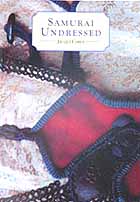
Samurai Undressed
by Jacqui Carey
6" x 8 1/2" Softcover (80 pages)
1995, The Devonshire Press, Ltd.
A suit of Samurai armour is a visually stunning work of art. Close examination reveals a wealth of intriguing detail and a beauty so particular to Japanese craftsmanship. A technique that has played an important part in armour construction, is Kumihimo, the art of Japanese braidmaking. The silk braids not only provided the necessary strength and flexibility needed to connect the lamellar armour, but also added to the aesthetic beauty of the suit.
Samurai Undressed attempts to reveal some of the hidden depths of Samurai armour and its unique relationship with Kumihimo. Extensive use of diagrams, makes those sometimes hard to visualise knots and loops understandable. It is also beautiful, which sets the scene for the beginning braider. In the introduction the author states that the goal of the book is to demonstrate that Kumihimo does not have to complicated to be beautiful. The six braid structures shown; Square, Round, Flat, Honeycomb, Hollow and Rounded Flat are all for 8 Bobbins. If you think that this might be limiting, think again, because after the clear instructions for each braid, there are two pages of photographs and full warp details for several variations. These include using different start positions, different thread thicknesses and adding texture. The photographs of the point of braiding at each sequence of the pattern moves, is particularly useful to the aspiring braider alone on the mountain top.
This gloss laminated book is illustrated using colour and monotone photographs throughout. Together with concise line diagrams, it provides an excellent reference for anyone interested in Kumihimo or the Samurai class.
Other works on Kumihimo by this author include: Beads & Braids, Beginner's Guide to Braiding - The Craft of Kumihimo, Braids and Beyond, Chinese Braid Embroidery, Creative Kumihimo, Round the Twist and 200 Braids to Twist, Knot, Loop or Weave as well as: Braids: 250 Patterns from Japan, Peru & Beyond, Kumihimo: Japanese Braiding, Making Kumihimo: Japanese Interlaced Braids, Kumi Himo: Techniques of Japanese Plaiting and Kumihimo - Japanese Silk Braiding Techniques by other authors.
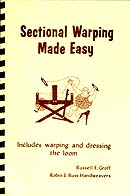
Sectional Warping Made Easy - Includes warping and dressing the loom
by Russell E. Groff
6 1/4" x 9 1/2" Spiral Bound Softcover (26 pages)
1988, Robin & Russ Handweavers
$15.95 Canadian ($12.95 US)
This little book provides complete directions for sectional warping using both pictures and words. It also includes the complete step by step procedure of dressing the loom after you put a warp on the sectional warp beam.
This book takes the reader through the process of sectional warping using a series of black and white photographs. Close up shots of each step simplify the process for those who can learn more easily by seeing it done with their own eyes. Each picture is accompanied by text explaining what is being done and suggesting alternatives. The author also includes a section identifying what equipment is required and another at the end with some example calculations.
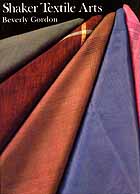
Shaker Textile Arts
by Beverly Gordon
6" x 8" Softcover (329 pages)
1980, University Press of New England
If you have ever wondered who the Shakers are? This book provides a fascinating look at the sect and their history with a focus on the textiles produced by the Shaker women. Both the equipment used and the textiles produced are documented as well as some of their methodologies. A sampling of weaving patterns, rug weaves, recipes for dyes and many other examples of Shaker works are provided all through the book which will help the reader acquire a much better understanding of an important piece of Americana.
The chapters in this book include: "Who the Shakers Were", "The Textiles Overall", "Production of Textiles", "Household Textiles", "Clothing and Personal Accessories" and are followed by 5 appendices entitled: "Location of Shaker Communities", "Government and Organization of the Hancock Community and Church Family", "Weaving Patterns", "Recipes and Instructions" and "Items Purchased in the Enfield, Connecticut Fancy Goods Store, 1910". The book is richly illustrated with many black & white and colour photographs and contains an excellent index, Reference section and glossary.
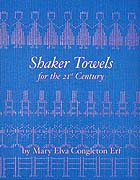
Shaker Towels for the 21st Century
by Mary Elva Congleton Erf
9" x 11" Spiralbound Hardcover (174 pages)
2005, Sexton Printing
Shaker Towels for the 21st Century is an indispensable reference for weaving fine linen and cotton yarns. The author's research and analysis of Shaker Textiles at Pleasant Hill. KY; Canterbury, NH; Sabbathday Lake, Maine; Hancock Shaker Village, MA; Winterthur Museum, Delaware, and many other collections led to methods for reproducing linen and cotton towels of the 19th century using materials available today.
Many weavers participated in making these reproduction towels, and in the process they discovered techniques for successful weaving with fine linens and cottons. This book has directions for 40 of these reproduction towels with helpful comments from the many weavers who wove them. Today one may view these reproduction towels at the following Shaker Villages: Canterbury, NH; Hancock, MA; and Pleasant Hill, KY.
The chapters include: "A History of the Shakers", "Preparation of Linen and Cotton Warps", "Reproduction Towels and a Blanket for the Metropolitan Museum, New York, by the author", Forty Reproduction Drafts: Bronson, Dimity, Huck, M's & O's, Plain Weave, Twills" and "a Manuscript of Seven Drafts from a 19th-century Shaker Sister". A glossary and bibliography are also included.
Mary Elva Erf is widely recognized as an authority on Shaker Textiles. She wove textiles for the Shaker Retiring Room at the Metropolitan Museum in New York City. She has taught workshops throughout the United States. Her students have woven many fine linen reproduction towels or rugs for Shaker museums.
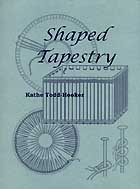
Shaped Tapestry
by Kathe Todd-Hooker
8 1/2" x 11" Spiralbound Softcover (77 pages)
2004, Fine Fiber Press
$30.95 Canadian ($25.95 US)
This book is filled with information about weaving tapestries "out-of-the-box". By this we mean, non-rectangular tapestries. Such tapestries can be shaped and lie flat on the wall or they can be three-dimensional.
There are many ways to weave a non-rectangular tapestry: shaping the loom itself, using weave structures that cause the weaving to become shaped, and using scaffolds and other devices to hold areas of warp that are then manipulated into 3-D shapes when the weaving is finished. Naturally, these types of techniques require some special finishing techniques, and this book covers those as well.
If you want a truly creative approach to this centuries old medium, this is the book for you.
Other books by Kathe Todd-Hooker include: Line in Tapestry, So Warped - Warping a Loom for Weaving Tapestry and Tapestry 101
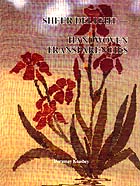
Sheer Delight - Handwoven Transparencies
by Doramay Keasbey
9" x 11 1/2" Hardcover (136 pages)
1990, Stellar Publishing House, Inc.
A transparency, as you probably know, is woven on a fine warp, with the pattern areas inlaid with a heavier yarn. When mounted in front of a window, the warp seems to disappear while the pattern appears suspended in air.
If you saw Doramay Keasbey's lovely and colourful transparencies, you'd probably want to weave one yourself. When we asked her to write this book, she asked a large number of very talented weavers in this country and elsewhere for examples of their work. Her efforts were richly rewarded. Dozens of weavers generously supplied her with photographs of their creations. The result is a delight to behold and a source of inspiration for your own transparencies. Besides giving you a gallery of phenomenal work being done in this area today, Doramay's book also explains how to do the techniques involved.
This book contains many example works in both colour and black and white along with diagrams showing methods and techniques. Designs by over 30 artists are shown in the chapter entitled "A Gallery Tour" which is followed by a collection of information on design and construction called "Advice by the Experts". After closing with a section on "Finishes and Methods for Display" the author provides an excellent Glossary, Bibliography and Index.
The author has also written the books Pattern Devices for Handweavers and Pattern Techniques for Handweavers.
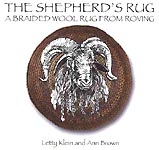
The Shepherd's Rug - A Braided Wool Rug from Roving
by Letty Klein and Ann Brown
9" x 8 1/2" Softcover (112 pages)
2006, Oak Woods Media
The braided rug is truly a part of American folk art. For 175 years braided rugs have been a symbol of home, family, comfort and cordiality.
A braided rug made from wool has the unmistakable character of warmth, richness and color that only wool can deliver. Rugs of this sort may well become heirlooms, to be passed on from one generation to another. Braiding a rug by hand connects one with a long tradition of making functional one-of-a-kind works of art. While most contemporary rugs are created to fill an empty space or match a decor, handmade braided rugs can have entire rooms built around them, becoming the main focal point for interior spaces.
This book is a complete yet simple guide to making your own braided wool rug. It provides background information on fibres and their preparation including selecting fleeces and washing the wool. The author then explains how to braid the wool before describing how to select a rug shape and plan its design. Examples include: "The Spiral Oval Rug", "The Butted Oval Rug", "The Spiral Round Rug", "The Butted Round Rug", "The Rectangular Rug" as well as variations such as "Chair Pads" and "Mug Rugs".
The author also covers subjects such as "Tips and Techniques" as well as "Taking Care of your Braided Rug" before individually examining 12 different sheep breeds in terms of their history and suitability in producing wool for braided rugs. Twenty pages of glossy colour photographs show beautiful example rugs from each of the breeds. A good Glossary, List of Suppliers, References and Index rounds off what is an excellent book on the subject.
This book was written for fiber artists with a closet full of fiber, shepherds wishing to make something from their sheep's wool, and handcrafters looking to add warmth and a decorative flair to their homes. It is also for those interested in homemaking traditions.
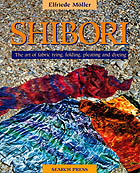
Shibori - The Art of Fabric Tying, Folding, Pleating and Dyeing
by Elfriede Moller
8 1/4" x 10 1/4" Softcover (64 pages)
2000, Search Press
The ancient Japanese craft of Shibori is a stunning form of fabric tying, folding, pleating & dyeing. The author modifies traditional techniques and shows how simple it is to transform, silk, velvet and other modern fabrics. Clear & colourful step by step photos will guide you through all the techniques, including how to manipulate your fabric to create fantastic & unique patterns.
After explaining the technique and the materials used, the author provides chapters on techniques which include Arashi, Mandala, Meander, Itajime and Pleating. This book is extensively illustrated with colour photographs of the finished works along with the various techniques.

Shuttle-Craft Guild Monographs
by Various Authors
Shuttle-Craft Books can trace its roots back to the 1920's and the days of Mary Atwater - she taught herself to weave and was instrumental in reviving the craft of handweaving in this country through her teaching and her weaving. She wrote up her procedures with detailed drawings, drafts and patterns and started her correspondance course.
Mary Atwater continued the Bulletin monthly until 1946 when she sold it to one of her students, Harriet Tidball. An intelligent weaver and prolific writer in her own right, Mrs. Tidball continued to write the Bulletin and consolidated information into the monographs which she published and distributed in the 1960's.
Harriet died in 1969 and in 1974 Bill and Virginia Harvey formed HTH Publishers and resumed the printing of the monographs. Virginia added her monographs to the series and other authos have contributed in-depth studies. In 1985 the business returned to the Shuttle-Craft name and has continued to add monographs and books to the series.
The following is a complete list of the Monographs with links to those that are still available:
| Number | Monograph Title |
| One | Double Weave - Plain & Patterned |
| Two | Surface Interest - Textiles of Today |
| Three | Design & The Handweaver |
| Four | Woolens & Tweeds |
| Five | The Weaver's Book of Scottish Tartans |
| Six | Mexican Motifs |
| Seven | Contemporary Satins |
| Eight | Peter Collingwood - His Weaves and Weaving |
| Nine | Undulating Weft Effects (Honeycomb) |
| Ten/Eleven | Merry Christmas, Handweavers Handwoven Specialties |
| Twelve | Contemporary Tapestry |
| Thirteen | Thomas Jackson, Weaver |
| Fourteen | Color Related Decorating Textiles |
| Fifteen | Guatemala Visited |
| Sixteen | Color and Dyeing |
| Seventeen | Supplemental Warp Patterning |
| Eighteen | Textile Structure, Drafts and Analysis |
| Nineteen | Summer and Winter - And Other Two-Tie Unit Weaves |
| Twenty | Two Harness Textiles: The Loom Controlled Weaves |
| Twenty-One | Two Harness Textiles: Open-Work Weaves |
| Twenty-Two | Brocade |
| Twenty-Three | Build or Buy a Loom/Patterns for Pick Up |
| Twenty-four | Contemporary Costume: Strictly Handwoven |
| Twenty-Five/Twenty-Six | Peru: Textiles Unlimited |
| Twenty-Seven | Weaving Inkle Bands |
| Twenty-Eight | Weft Twining |
| Twenty-Nine | Handwoven Rugs |
| Thirty | Creative Monk's Belt |
| Thirty-One | Creative Overshot |
| Thirty-Two | Doup Leno - A Quick and Simple System for Weaving Loom-Controlled Leno |
| Thirty-Three | The Handloom Weaves |
| Thirty-Four | Handweaver's Instruction Manual |
| Thirty-Five | Multiple Tabby Weaves |
| Thirty-Six | Bateman Blend Weaves |
| Thirty-Seven | Park Weaves |
| Thirty-Eight | Boulevard, Chevron and Combination Weaves |
| Thirty-nine | Extended Divided Twill Weaves |
| Forty | Extended Manifold Twill Weaves |

Sling Braiding of the Andes
by Adele Cahlander
8 1 /2" x 11" Softcover (96 pages)
1980, Colorado Fiber Center, Inc.
Weaver's Journal Monograph IV
Used for battle, farming, hunting and in religous ceremonies, evidence has shown that slings have been used almost everywhere in the world by primitive cultures. This book includes photos and patterns of slings and braids used by the Andean herders from pre-Incan times to the present day. The author examines the history, use and design of various types, classifies them and shows the techniques needed to reproduce many of the designs shown. Extensively illustrated with black & white and colour photos showing examples and technique, this is a fascinating glimpse into one aspect of an ancient culture.
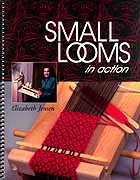
Small Looms in Action
by Elizabeth Jensen
8 1 /2" x 11" Spiral Bound Softcover (64 pages)
1997, Brescia's Printing Services, Inc.
Using small looms can be an excellent way to sample yarns and learn about weave structures, setts and colour combinations that can be used on larger pieces. Small looms can also be used to make small items such as purses, belts, scarves, jewelry and accessories. All of the looms described in this book - including the laptop Inkle and integral looms - can be transported easily. There are descriptions for many interesting projects as well as a section on tools and accessories. This is an excellent reference for beginner weavers as well as more experienced weavers who want to explore different weave structures on a smaller scale.
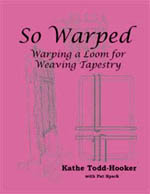
So Warped - Warping a Loom for Weaving Tapestry
by Kathe Todd-Hooker and Pat Spark
8 1/2" x 11" Spiralbound Softcover (110 pages)
2010, Fine Fiber Press
After many years of teaching tapestry and weaving, the authors realize that it is sometimes the warping process that stops a weaver dead in her/his tracks. Traditional weavers often have horror stories about their warping experiences and while many tapestry weavers do not have a background in traditional weaving, they too often see the process as impossibly difficult.
In this book the authors are covering as many warping methods and hints as their combined 60 years of experience have taught them. They have learned these methods through much trial and error. They are certain there are other ways of doing things, but they have hit upon the methods that work well for them and for their students.
To help understand warping, they present different types of tapestry looms, various tensioning and shedding mechanisms including several types of heddles, and the following warping methods: figure eight, circular, bout, four-selvedge, floor loom, and as an added treat, the method of warping the Russian Old Believer backstrap loom for weaving tapestry belts.
There are 110 pages of information for warping the oom so the reader can weave tapestry. If you aren't warped before you read this book, So Warped will really help you get there!
Other books by Kathe Todd-Hooker include: Line in Tapestry, Shaped Tapestry and Tapestry 101
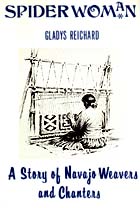
Spider Woman - A Story of Navajo Weavers and Chanters
by Gladys Reichard
6" x 9" Softcover (287 pages)
1994, The Rio Grande Press, Inc.
First published in 1934, this book chronicles the author's time with the Navajo weavers of New Mexico and provides an insight into their ways and customs. The author provides a number of black and white illustrations.
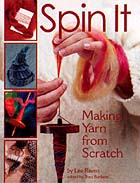
Spin It - Making Yarn from Scratch
by Lee Raven
8 3/8" x 10 7/8" Softcover (33 pages)
2003, Interweave Press
$12.95 Canadian ($10.95 US)
Have you ever imagined making your own yarn? With only a handspindle and this invaluable guidebook, you can explore the fascinating craft of spinning wool into yarn for knitting, crocheting or other fibre projects. Designed to appeal to the beginner, this book provides tips and techniques that make spinning easy, enjoyable and relaxing.
Handspindles are simple tools that help you to turn wool into yarn: from a potato on a stick, to beautiful handcrafted wood spindles and new-age titanium spindles with CD whorls. This little book will teach you all you want to know about handspindles. Included are complete instructions for five simple, appealing projects including: "knitted Handwarmers", "Crocheted Felted Hat", "Knitted Bunny Bag", "Woven Scarf" and "Knitted Turquoise Tornado Baby Cap". The book is well illustrated with colour photographs and step-by-step instructions on how to card wool, spin and even make your own spindle.
Once you begin spinning on a handspindle, you won't want to stop - it's soothing, portable and mesmerizing.
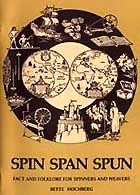
Spin Span Spun - Fact and Folklore for Spinners and Weavers
by Bette Hochberg
5 1/2" x 8 1/2" Softcover (66 pages)
1998, Bette Hochberg
$13.95 Canadian ($11.95 US)
For many of us, just knowing how to spin and weave is not enough. We feel a kinship with the past, and want to know something of our traditions. But these traditions are hard to uncover. There is yet no formal history of spinning around the world, because there are still so many gaps in our knowledge. There are only fragments and studies of particular areas of our craft.
Here are some of the myths and legends, records and anecdotes, which make up our legacy of spinning and weaving lore. Some of you will read them for entertainment, some for helpful hints, and some will view them as fibres from which they can spin their own tales of spinning and weaving.
This delightful book contains page after page of historical, biblical, fictional, mythological, and biological references to spinners, spinning, wool, cotton, flax, spinning wheels and spinning. While the book will not make you a better spinner, it will give you a lot of enjoyable reading.
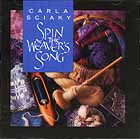
Spin the Weaver's Song
by Carla Sciaky
CD or Cassette (length 60 minutes)
1992, Green Linnet Records, Inc.
What music do you listen to when you are weaving? Carla Sciaky has put together an hour of music covering 30 songs from around the world related to weaving and spinning. These are a perfect way to celebrate the Fibre Arts and cover fabric production starting with songs about Sheep Shearing, Spinning, Cotton Picking and of course weaving. A must for the Weaving enthusiast!
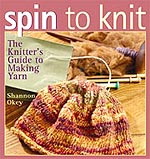
Spin to Knit - The Knitter's Guide to Making Yarn
by Shannon Okey
8 1/2" x 9" Softcover (128 pages)
2006, Interweave Press
$25.95 Canadian ($21.95 US)
Take your knitting to a new level with the addition of handmade yarn! Spinning is easy to learn, handspun yarn is hot , and with Spin to Knit everything you need to create fun, funky, one-of-a-kind designer yarn is right at your fingertips.
Spin to Knit teaches you all the details about fibers, tools, and materials for getting started spinning, and offers a substantial selection of simple patterns for knitting with that fabulous yarn you've created all on your own. Don't want to spin a lot of yarn? No problem, you'll find lots of ideas for combining your precious handspun with commercial, mill-spun yarns or for accenting sweaters and accessories you already own.
Urban spinner Shannon Okey, author of KnitGrrl, answers all your burning questions about spinning basics. For instance, what fibers are good for close-to-the-skin projects, what's good for layering, and what on earth can you do with dog fur or recycled fabric? Find out the basic tools you need to get started spinning, whether you should begin with a drop spindle or a wheel, why "lumpy bumpy" yarn is your friend, ways to un-lump your yarn, and how to control singles, twist, and ply. Incorporating color in spinning is also introduced, from "dishwasher dyeing," to incorporating beads, thread, or other media into yarns for visual interest.
Inventive patterns include a "cardiganized" thrift shop pullover with a gorgeous handspun buttonband, a faux Fair Isle pullover that combines millspun and handspun yarn, a traditional lace shawl, a shrug based on a woven Swedish heart, a silky sweater made entirely from hairdresser's rayon, and much more.
A great feature of Spin to Knit is the addition of in-depth profiles about urban spinners from all over the country. Learn the personal stories of how these spinners got started, and their insider tips for spinning with style.
Are you bored with commercial yarns? Dare to be different and accessorize all your knitted garments with handmade yarn. Become a full-fledged fiber fanatic with Spin to Knit, the easy guide for any knitter to easily transform into a spinner!. The book is well illustrated with 150 photographs and 25 drawings.
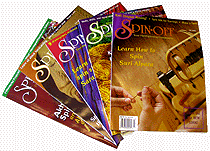
Spin-Off
8 1/2" x 11" Magazine
Interweave Press
Pricing Varies
Step into Spin-Off and find a neighborly community of spinners ready to share their knowledge. But Spin-Off will also whisk you away! Travel around the world to discover new and old spinning tools; sit down with knowledgeable instructors and learn new spinning techniques; step into spinners' homes and discover friends whose craft and experience will enrich your life. And every issue of Spin-Off will inspire you to take your own exciting journeys with your spinning wheel. Published four times a year in March, June, September and December.
We have a selection of New Copies of the magazine covering the last few years.
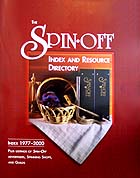
The Spin-Off Index and Resource Directory - Index 1977-2000
by Spin-Off Magazine
8 1/2" x 11" Softcover (112 pages)
2001, Interweave Press, Inc.
$12.95 Canadian ($10.95 US)
With over 80 issues of Spin-Off published since 1977, this is an incredible resource with all articles indexed by subject under one cover. The index is broken down into two main sections. The first groups the articles by Author/Designer letting you find everything written by a specific writer, while the second arranges the articles by Subject. The index includes a guide to key websites, organizations, and retail outlets. A great kick-off to Spin-Off's 25th Anniversary in 2002!
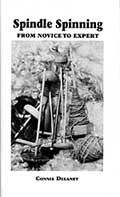
Spindle Spinning - From Novice to Expert
by Connie Delaney
5 1/2" x 8 1/2" Softcover (80 pages)
2002, Kokovoko Press
$19.95 Canadian ($16.95 US)
Learn to spin yarn from wool and other fibers!
This book leads the reader, with the humor and skill of a patient teacher, from your first day to fine silk thread. Shows you the best methods for all types of spindles - top-whorl to Navajo - even how to make your own spindle!
The book includes wool preparation, detailed and illustrated instructions for basic skills, plus more advanced techniques for plying, winding on, wrist distaffs, skein-making, and improving speed.
This is a manual for the spinner, who, like most spinners around the world do their spinning the time worn way on a weighted stick of some form or other. A very well produced text with good essays on spinning and clear line drawings and photos of the various processes and techniques, this slim tome will inform the novice and inspire the expert.
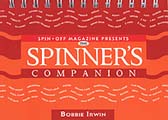
The Spinner's Companion
Bobbie Irwin
7" x 5 1/2" Spiralbound Softcover (110 pages)
2001, Interweave Press, Inc.
An Age-Old Craft Gets a New Tool!
Finally, a quick reference guide to spinning for spinners! Use this book as a resource and a guide - it's the tool to turn to when you have questions about spinning. What is a nostepinne? How do you ret linen? What is the usual micron count of Merino? How do you degum silk? What fibres are stronger when wet? It's all here wool characteristics charts, Bradford count and micron count charts, how to wash wool, how to splice a drive band, how to prevent repetitive motion injuries, where to find spinning chat rooms on the internet, and much, much more.
Other books by this author include Twined Rag Rugs.
Other books in this series include The Crocheter's Companion, The Dyer's Companion, The Knitter's Companion and The Weaver's Companion.
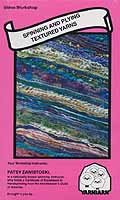
Spinning and Plying Textured Yarns
instructed by Patsy Zawistoski
DVD Video (117 minutes colour)
Victorian Video Productions
$25.95 Canadian ($21.95 US)
This video will teach you how to make textured yarns. The instructor provides detailed information on fiber characteristics that work (or don't work) with each of seven recipes she provides for making different types of yarns. The seven recipes -- cabled, knotted, soft twist singles, spirals from different singles, 3-pass boucles, core-spun boucles, and mixed twist "illegal" spirals -- provide the foundation for spinning texture variations. By combining these recipes with the nine design factors (size, plying, twist compared to size, preparation and drafting style, fiber crimp, mixing fiber plies, garneting, fiber body, and irregular twist construction) the student will be able to create an endless supply of unusual and beautiful one-of-a-kind textured yarns.
Though this video, the viewer will learn about the importance of control yarns and a quick way to skein and set the twist. The section on twist analysis will help you figure out how much plying each type of yarn needs. The student will also learn how to combine many different fibers together, even sewing thread, to spin these unique textured yarns. The instructor's thread-in-a-bag trick will make the process of using sewing thread seem effortless.
And, if you have some yarn on the shelf that you want to repeat or spin from scratch, the unraveling and decoding segment will help you figure out how it was spun. This video provides all the ingredients you need for successful yarn design. Just stir them up to create spinning magic!
This is an intermediate level spinning video. The student should know how to spin and understand spinning terminology, the difference between s and Z twist, combed and carded preparations, wheel speeds, and woolen and worsted drafting techniques. Many of these topics are covered in the instructor's Spinning Wool - Basics & Beyond video. For materials the viewer will need an array of various spinning fibres, 3" x 5" note cards, hang tags, a wet towel in a bag, and, of course, their spinning wheel.
The instructor's other videos include Spinning and Plying Textured Yarns, Spinning Cotton, Silk & Flax and Spinning Wool - Basics & Beyond.
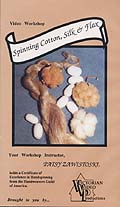
Spinning Cotton, Silk & Flax
instructed by Patsy Zawistoski
DVD Video (111 minutes colour)
Victorian Video Productions
$25.95 Canadian ($21.95 US)
Cotton, Silk & Flax are three of the finest spinning fibres. Today each fibre is available for the handspinner in its own unique forms. Each Fibre will be dealt separately during the video, with information on choosing and preparing fibres as well as spinning techniques. Different drafting and finishing techniques which effect the resulting yarn are also explained, along with tips on adjusting wheels and record keeping. In the Cotton section the instructor will work with ungined bolls, ginned and carded lint, punis and combed sliver. The Silk section includes techniques for degummed cocoons, semi carded batts, bells, noil roving, brick and combed sliver. In the flax section, Patsy will work with combed flax top, line and carded tow.
The only prerequisite of this course is that the spinner be comfortable with their wheel and know how to spin wool fibres. In addition to their spinning wheel and hand cards, the student will need the silk, cotton and flax fibres mentioned above. A detailed written insert is provided in the video package, along with recommendations on quantities needed for each fibre.
The instructor's other videos include Spinning and Plying Textured Yarns and Spinning Wool - Basics & Beyond.
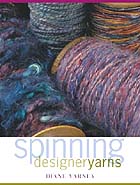
Spinning Designer Yarns
by Diane Varney
7 x 9 1/2 Softcover (96 pages)
2003, Interweave Press
$21.95 Canadian ($17.95 US)
Few things are as satisfying as creating the perfect yarn for a special project. This book, first printed in 1987, leads the new or intermediate spinner gently into the world of super-soft luxury fibres, textured effects, and the dyepot's miracles. Learn to apply dye to fibres in new, exciting ways; predict how novelty yarns will look in finished fabrics; blend fibres for colour and texture effects; and spin simgles and plied yarns in ways that will put more zip in your spinning -- and your weaving, knitting and crocheting. Corespun, boucle, snarl, knotted and tufted yarns will become part of your spinning repertoire, and you'll rediscover the excitement of spinning all over again.
This inspiring illustrated guide teaches experienced spinners to make beautiful designer yarns and encourages them to be more creative and have more fun with spinning. Handspun yarns can be white, lumpy, gray, and precise-or they can be as colorful and deliciously textured as the spinner's imagination. This book is illustrated with 16 colour photographs and 28 illustrations.
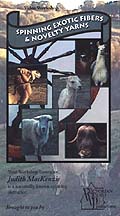
Spinning Exotic Fibers and Novelty Yarn
instructed by Judith MacKenzie
DVD Video (96 minutes colour)
Victorian Video Productions
$25.95 Canadian ($21.95 US)
In this course the viewer will learn how to spin many exotic fibres including Camel, Llama, Alpaca, Cashmere, Angora, Dog, Rabbit and of course Quiviuet from our friend the Musk Ox. The video also includes live footage of many of these animals so that you can become better acquainted. You will also learn how to spin many types of novelty yarn (including spiral, gimped, boucle, turkish knot and cocoon) using a combination of fibers and spinning techniques (including frosting & encasement). Tips on buying these fibers and the best end use of the yarn is also included.
The only prerequisite of this course is that the spinner be familiar with their spinning wheel and feel comfortable spinning and plying wool fibre. The viewer will learn to spin all the fibres listed above and to do so, one to two ounces of each fibre will be enough with which to practice.
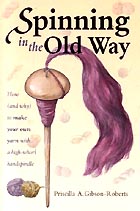
Spinning in the Old Way - How (and why) to make your own yarn with a high-whorl spindle
by Priscilla A. Gibson-Roberts
6 1/4" x 9 1/4" Softcover (176 pages)
2006, Nomad Press
$19.95 Canadian ($16.95 US)
Although it does not indicate it inside, this book is essentially a paperback version on the author's earlier High Whorling - A Spinner's Guide to an Old World Skill book with updated pictures and some minor updated content.
Loose fibers become yarn because of twist, which holds them together. A bunch of loose fibers will fall apart if you pull on their ends. Just by adding twist, you can create yarn that is sturdy enough to be knitted or woven into fabric.
What's almost as remarkable is that you can spin perfect yarn with simple, inexpensive tools. All you need is a high-whorl handspindle, uuspun fiber, a few yards of leftover knitting yarn, and the gentle guidance of master spinner and knitter Priscilla Gibson-Roberts.
Whether you're a curious newcomer to fiber crafts, a knitter who wants to know why to bother with spinning, or a long-time spinner looking for new and better ways to make the pertfect strand, you'll love this book.
Spinning in the Old Way is an inviting book for the new spinner, covering all aspects of spinning with the high whorl handspindle from fiber selection and preperation to detailed spinning technique. It is also the ideal guide for those with previous experience in low whorl or wheel spinning who wish to take up the high whorl.
Spinners at all levels will want to study Priscilla A. Gibson-Roberts in her (sometimes surprising) approach to fiber and spinning technique, her choice of hand tools, and her own carefully worked out methods of yarn finish. With a warm touch and plenty of clear illustrations, learn everything you need to know about this ancient and inspiring craft.
Other books by this author include: Ethnic Socks & Stockings, , Knitting in the Old Way and Simple Socks, Plain and Fancy.
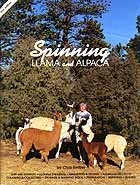
Spinning Llama and Alpaca - 2nd Edition
by Chris Switzer
11 x 8 1/2 Softcover (50 pages)
1998, Switzer Land Enterprises
$21.95 Canadian ($17.95 US)
This newly revised edition of Chris Switzer's 1994 book provides a wealth of information on Llamas and Alpacas for those that wish to raise them or simply want to learn more about the breed and their wool. Starting with a technical understanding of the breeds and how they evolved, Chris describes the characteristics of the wool and how to shear, test, prepare, blend, dye and spin it.
A number of projects including a Knitted hat and headband as well as a Woven shawl, scarf and belt are included with instructions. The author also includes samples of the wool as well as many references for further information on the subject. This updated second edition of the book includes an updated shearing section, additional projects, a Bibliography that has doubled in size as well as other updates and revisions.
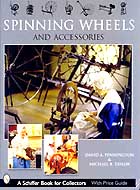
Spinning Wheels and Accessories
by David Pennington & Michael Taylor
8 3/4 x 11 1/4 Hardcover (224 pages)
2004, Schiffler Books
$72.95 Canadian ($60.95 US)
Collectors, antique dealers, and textile tool lovers will rejoice: Pennington and Taylor are back with another great book about spinning wheels, including over 350 color photos to illustrate their painstaking research. Their emphasis is the American spinning wheel from 1775-1900, with substantial sections on fancy European wheels and the accessories that textile tool collectors crave.
Special sections are devoted to Shaker wheels, patent wheels, and famous makers. In addition, there is extensive coverage of chair wheels, Irish castle wheels, double flyer wheels, and an appendix with over 1000 makers and their marks. The pictured items are all from important private collections that have never been seen before including some European fancies that have sold for over $25,000. The book also has a price guide in US$.
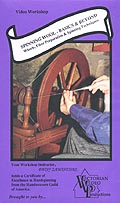
Spinning Wool - Basics & Beyond
instructed by Patsy Zawistoski
DVD Video (90 minutes colour)
Victorian Video Productions
$25.95 Canadian ($21.95 US)
Wheels, Fiber Preparation & Spinning Techniques
This very complete spinning video is designed for the beginner to intermediate level spinner. It begin9 with a thorough explanation of a spinning wheel and how it works and continues with a detailed explanation of single drive band, double drive band and bobbin lead spinning wheels. If you haven't purchased a wheel yet, this will help you select just the right one for your needs. You will learn about wheel set-up, fiber preparation and how to spin various fiber preparations. You will also learn about pre-drafting, the importance of understanding the purpose of wraps per inch, how to use a control yarn, plus step-by-step instructions for spinning various wool fiber preparations. All of this, plus methods for plying will make your handspun yarn successful and even more beautiful.
While their are no prerequisites for this course, the student will need a spinning wheel, various fibre preparations and some hand carders. A detailed written insert is provided in the video package detailing the materials needed.
The instructor's other videos include Spinning and Plying Textured Yarns and Spinning Cotton, Silk & Flax.
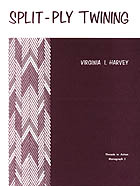
Split-Ply Twining
by Virginia I. Harvey
8" x 10 1/2" Softcover (46 pages)
1976, Virginia I. Harvey
Threads in Action Monograph I
After seeing examples of this technique in 1974 in some camel girths from northern India, the author has produced this monograph to attempt to explain this form of fibre manipulation in which the yarn is pulled through the ply of another. As no documentation or name for the technique had existed, she coined the name "Split-Ply Twining" and created a nomenclature to document it. After defining the terms and analysing the structure and the materials used, she provides a series of samples before discussing how to create unique designs. She then examines three camel girth designs, introduces more complexity by looking at 3-dimensional constructions and then provides the reader with a chapter on finishing the project.
This monograph is illustrated with photographs of split-ply designs as well as drawings showing the techniques used. It is a great way for the reader to understand this ancient art as well as to learn the technique.
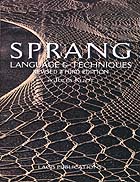
Sprang - Language & Techniques (Revised Third Edition)
by Jule Kliot
8 1/2" x 11" Softcover (24 pages)
2002, Lacis Publications
Sprang is a net type fabric formed solely from parallel warp strands stretched between two supports. No weft is involved as the fabric is formed by the twisting of select warp threads around each other. Characteristic of this fabric is its stretchiness and mirrored symmetry about an axis perpendicular to the warps. Unless stretched and held in tension in all directions, it will collapse into a tight band. It is this characteristic which makes it ideal for such items as shopping bags, hammocks and stretch garments. The symmetry is the direct result of the twisting as each twist made is mirrored above and below on the same warps. Although the twist motion will be the same on the far end of the warp, the twist will be of the opposite direction.
This book describes the basic techniques of Sprang and establishes a language for its understanding and dissemination. It covers such areas as "Twists", "Plaiting", "Twills", "Lace Sprang", "Complex Stitches", "Double Sprang", "Special Techniques", "Working Techniques" and "Finishing". The book is illustrated using clear line drawings of the various techniques.
The author has also written: Kumi Himo: Techniques of Japanese Plaiting, Tapestry Loom Techniques: Exploration of the 2 Harness Loom and The Vertical Loom - Principles and Construction.
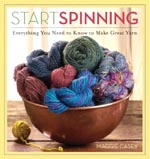
Start Spinning - Everything you Need to Make Great Yarn
by Maggie Casey
8 1/2" x 9" Softcover (119 pages)
2008, Interweave Press
$25.95 Canadian ($21.95 US)
The art of spinning is growing in popularity as knitters, new and experienced, want to make their own yarn. All it takes is some fluff, a spindle or wheel, and a little practice! Maggie Casey, a veteran spinning teacher, takes complete novices to competent spinners in Start Spinning: Everything You Need to Know to Make Great Yarn.
Based on the authors time-tested Spinning 101 workshop, which she has taught for twenty-two years, readers will learn to spin the yarn of their dreams beginning with an introduction to the various types of fibers available, choosing and preparing (or buying) fiber with which to spin, and detailed instructions for both spinning on a spindle and spinning on a wheel, with extra detail on Wheel 101 complete with plenty of photos. The author also offers a special section on troubleshooting and wheel maintenance, plus tips and tricks for creating better yarns. Then she moves into plying, setting twist, using a niddy noddy, and woolen and worsted spinning. Maggie concludes with a chapter on uses for spun yarn, which covers wraps per inch, measuring yards for projects, and size of yarn.
Start Spinning covers all the basics newbies need to spin their own fabulous yarn. Using yarn handspun to your own specifications is like tasting a delicious strawberry from your own garden; once spinners get comfortable creating new and wonderful yarns, anything is possible!
Start Spinning takes the reader from loose fiber to yarn made on a spindle and spinning wheel, and with friendly advice and a sure hand at every step makes this book an indispensable reference.
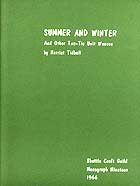
Summer and Winter - And Other Two-Tie Unit Weaves
by Harriet Tidball
8" x 10 1/2" Softcover (58 pages)
1966, Shuttle-Craft Books, Inc.
Shuttle Craft Guild Monograph Nineteen
A comprehensive study of the Summer and Winter weave including drafts, block arrangement and methods of weaving. Modern interpretations of this versatile weave are stressed. Drafts for 4, 6 and 8 shafts. Other Two-Tie Unit systems are also explored. Chapters include: History of the Summer & Winter Weave, Tie Ups, Selvages, Weaving Methods, Balance and Yarns, Taking a Draft from a Textile, and Drafts and Patterns.
Click Here for a full list of the Shuttle-Craft Guild Monographs currently available.
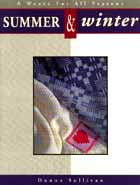
Summer & Winter: A Weave for all Seasons
by Donna Sullivan
7" x 9 1/4" Softcover (112 pages)
1991, Interweave Press, Inc.
Summer and Winter is a traditional American weave structure, best known for its use in some of the blue-and-white Early American coverlets. The name comes from these colonial fabrics, which were predominantly dark on one side and light on the other. In this book, Donna Sullivan shares her knowledge of the traditional uses of summer and winter, as well as a number of new applications which stretch the limits and expand the creative horizons of this familiar structure.
Every weaver should know summer and winter, for its historic value. Every weaver will want to discover this weave, for the wide variety of radically different fabrics which can be woven with it. A brief glance at this book hints at the possibilities for developing both textural effects and colour interactions; summer and winter invites continual exploration.
The new weaver who can read a draft will discover here a simple weave system capable of producing sophisticated results. The experienced weaver will learn to master what is truly a "weave for all seasons".
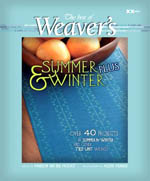
Summer and Winter Plus - The Best of Weaver's
from Weaver's Magazine
9" x 11" Softcover (123 pages)
2010, XRX Books
Creating exciting, luxurious fabrics will come easily to beginning and experienced crafters alike with this compendium of special weaving structures.
Featuring more than 40 projects and instructions for designing and drafting more designs, the guide presents weavers with detailed directions for summer, winter, diamond, taquetˇ, samitum, and polychrome weaves. This collection features patterns for coverlets, garments, table linens, and rugs.
Articles and projects in this book include: "Going in Circles Runner", "Tablecloth in Summer and Winter", "Woven to Scale", "Woven Imagery in Summer & Winter", "A Family Table", "Roses in Summer & Winter", "Pueblo Coat", "Pierced Peru Vest", "Sea Horse Sweaters", "Recapture the Fall with Summer & Winter", "A Spread for any Season: Summer & Winter", "An Introduction to Tied Unit Weaves and Their Relatives", "Three-Tie Unit-Weave Textures", "A Pick-up Handbook for Tied Unit Weaves", "Designing with Ties", "Designing Stars and Diamonds", "To Tie or Not to Tie", "Starry Latice Runner", "Tablecloth in Bergman Weave", "Boulevard Square Scarves", "Holiday Cards in Metallics", "Four-Shaft Fantasies", "Taquete and Samitum", "Taquete for Tots: Pictures for the Nursery", "Four Color Taquete", "Taquete Rugs", "Sumptuous Samitum", "Samitum on Four", "Fabric Store as a Design Source", "Samitum Rug", "Weft-Faced Color-and-Weave with Two-Tie Units", "Reversible Rug with Network Drafting", "Color Mysteries of Summer & Winter", "Changing the Seasons: a Sampler", "Summer & Winter's New Look", "Summer & Winter Pick-up Tips and Tricks", "Satin Ideas for Eight-Shaft Weavers: Six Summer & Winter Placemats", "How to Start at the End of a Project", "Diagonal Jacket", "Night Sky Vest", "Color & Texure Windows in Variable-Tie Summer & Winter" and "Double Two-Tie Unit Weave".
The other books in the Best of Weaver's series include: Fabrics That Go Bump, Huck Lace, The Magic of Doubleweave, Overshot is Hot!, Thick'n Thin and Twill Thrills.
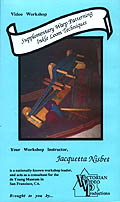
Supplementary Warp Patterning Inkle Loom Techniques
instructed by Jacquetta Nisbet
DVD Video (87 minutes colour)
Victorian Video Productions
This course shows you how to weave a magnificent warp-faced pattern structure from ancient Peru, while learning optimum inkle loom techniques. You will learn about choices in looms and tools, yarn preparation, heddle making and setting up the loom, color principles, and how to read and design pattern drafts.
The first of two projects is a narrow belt or bag strap introducing you to pattern picking on a small scale. The second textile, the bag body, is wider and more complex in design and color. It can be woven as a 7" wide textile, or as two 3 1/2" wide strips, depending on the width of your inkle loom.
Finishing techniques include bag construction and fringe making - (or you can proceed to the video Tubular Woven Finishes-Backstrap Loom Techniques to learn how to make decorative ribetes and bands). An overview of Andean textiles, and works by the author, provide an idea of the range and diversity of this intriguing weave.
While their are no prerequisites for this course, the student will need a sturdy inkle loom, 6" or 10" beater or belt shuttle, about 12 colors of hard twist worsted wool yarn, (about 1 to 3 pounds, depending on project choices), and 2 slim shed sticks. A detailed explanation and further yarn and tool details are included on the written insert along with pattern graphs.
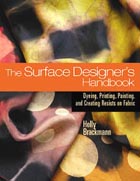
The Surface Designer's Handbook - Dyeing, Printing, Painting, and Creating Resists on Fabric
by Holly Brackmann
9 1/2" x 11 1/2" Spiralbound Hardcover (138 pages)
2006, Interweave Press
Learn to create richly patterned fabrics with The Surface Designer's Handbook, the most comprehensive book for learning how dyes work and using them with surface design techniques. Author Holly Brackmann draws on more than 30 years of experience with studio dyeing techniques, providing a wealth of information on dyeing and surface design not found in any book currently in print.
The Surface Designer's Handbook will help crafters understand which dyes work best with which fibers, and how to apply this knowledge to create unique, original fabrics.
Begin by learning the basics of studio practices and safety measures, appropriate fibers and fabrics, and then move into all aspects of the major dye groups most accessible to studio dyers: fiber reactive, acid, vat, and disperse. The dyes are then used to alter and change surfaces by discharging, screen printing, monoprinting, stamping, stenciling, resist dyeing, dˇvorˇ, and painting. Then learn how to embellish your fabric with foiling, embroidery, beadwork, or collage.
Recipes for dyes and techniques covered in the book are accompanied by step-by-step instructions and process photographs, making them clear and easy to follow. Brackmann shares tips and tricks gleaned from her three decades of experience in studio dyeing and helps you identify your personal approach to dyeing-are you a creative free spirit, or do you prefer to follow precise rules?
The hardback format with concealed spiral binding makes The Surface Designer's Handbook easy to use, as the book can lie flat while you're consulting a recipe. The dye worksheet can be used to calculate and record dyes, chemicals, procedures, and costs for all dye projects. Color photos of works from some of the top fiber artists today that are included throughout the book are certain to inspire artists of any background.
The Surface Designer's Handbook will appeal to a wide audience of students, teachers, hobbyists, or beginner surface design artists. Whether you're an experienced dyer or surface designer or you're just starting out, this book is certain to become your essential reference tool!
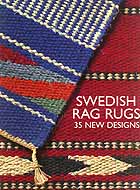
Swedish Rag Rugs - 35 New Designs
edited by Lillemor Johansson, Pia Wedderien and Marie Rolander
9" x 11 3/4" Hardcover (95 pages)
2004, VavMagasinet
This wonderful English translation of the 1995 Swedish classic Rag Rug pattern book is finally back in print!
Swedish Rag Rugs contains 35 rug designs, woven in 12 different techniques, all with rags for the weft. The weaves commonly used for rag rugs, tabby and double-faced weave, are well represented, but this selection also includes some new, exciting variations such as Moorman, reversed block twill, taquete pick-up and tied triple weave. The rugs have been created and woven by designers and weavers from all over Sweden. Marie Rolander's work features strongly, along with contributions from Eva Arnesdotter-Schwyzer, Gisela von Wiesz, Boel Muller, Lena Mansson, Catharina Goth, Kerstin Eberhardsson and her students at Capellagarden, Lotti Soderlund and Ingela Johansen. Not to mention some industrious weaving at the Scandinavian Weaving Magazine office.
Lillemor Johansson, one of the editors of this book has also written Damask & Opphamta: With Weaving Sword or Drawloom, co-edited Happy Weaving from VavMagasinet and was the long time editor of VavMagasinet, the Scandinavian Weaving Magazine.
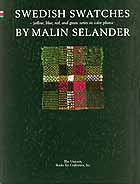
Swedish Swatches - yellow, blue, red and green series in colour photos
by Malin Selander
9 1/2" x 11 1/2" Hardcover (62 pages)
1990, The Unicorn Book for Craftsmen, Inc.
Swedish Swatches is a combination in revised form of four "Swatch" books by Malin Selander, published under the common title Swedish Swatches and subtitled: Yellow Series (1962), Blue Series (1969), Red Series (1974) and Green Series (1978). From each volume, 15 patterns have been selected for inclusion in this volume of 60 patterns with weaving instructions and adjoining colour plates.
The fabrics have been chosen with a view to being a joy to all weavers, those who prefer traditional techniques as well as those who love to experiment with techniques and blending of various types of yarns. All kinds of fabrics are presented for execution in delicate as well as coarse quality, from 2 to 190 harnesses. Instructions are simple and easy to follow.
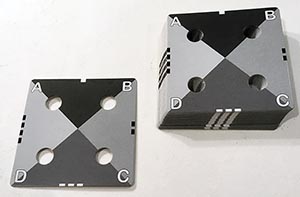
Tablet Weaving Cards
25 x Square (3 1/2" x 3 1/2")
Cardweaving Cards (4 holes)
Available at great prices with quantity discounts!
Click here for more Information
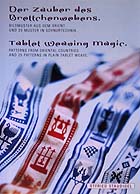
Tablet Weaving Magic - Patterns from Oriental Countries and 25 Patterns in Plain Tablet Weave
by Otfried Staudigel
7 1/2" x 10 1/2" Softcover (250 pages)
2000, Libri Books on Demand
Otfried Staudigel is a second-generation tablet weaver who has bee teaching this craft for more than a half a century. This experience, together with his ability to explain technical processes, is reflected in this book which shows with clear diagrams how to weave more than a hundred authentic patterns from oriental countries, most of which have never been previously published. "Tablet Weaving Magic" is a must for every serious tablet weaver, and is of eminent interest for students of oriental design. - - Peter Collingwood
Written in both English and German , the author starts out by explaining the history of Tablet Weaving and then, after covering the equipment required, teaches the reader how to weave. A collection of 101 patterns are then presented using black & white photographs of each piece accompanied by descriptive information and followed by detailed patterns. In the project section, the author then provides instructions for "25 Colored Bands in Plain Tablet Weave". The book closes with a list of references as well as information on weaving tools and sources.
CLICK TO SEE OUR TABLET WEAVING CARDS AT A VERY AFFORDABLE PRICE!
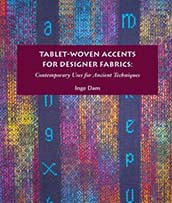
Tablet-Woven Accents for Designer Fabrics - Contemporary Uses for Ancient Techniques
by Inge Dam
8 3/4" x 10 1/4" Hardcover (134 pages)
2013, Inge Dam
$46.95 Canadian ($38.95 US)
Inge Dam's unique handwoven fabrics incorporating tablet-woven borders and accent bands are inspired by ancient textiles discovered in Danish bog and burial sites. In this book, Inge describes the five tablet-weaving techniques she uses (Warp-Twined, Regular Double-Faced, Double-Faced 3/1 Broken Twill, "Missed Hole", and Pebble Weave) and explains her process for incorporating tablet weaving into loom-woven fabrics. She shares some unique border treatments and embellishments and provides pattern motifs and project ideas. The instructions are clear and well-illustrated with over 320 photos, diagrams, and drawings. Weavers who wish to expand the possibilities for creating decorative and fashion fabrics will find this a valuable guide. Tablet weavers will find exciting new applications for their weaving.
CLICK TO SEE OUR TABLET WEAVING CARDS AT A VERY AFFORDABLE PRICE!
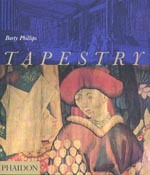
Tapestry
by Barty Phillips
9 3/4" x 11 1/2" Softcover (240 pages)
2000, Phaidon Press Ltd.
Tapestry weaving is an old and honoured skill, which produces textiles of unsurpassed richness and decorative power. The great flowering of tapestry in the Middle Ages has left an extraordinary legacy of mysterious motifs and bright images. During the Renaissance the rising status of the artist meant that tapestries became, and were to remain, woven pictures based on artists' cartoons, the most famous of which are those by Raphael. In the seventeenth and eighteenth centuries vast numbers of tapestries were produced not only for royalty and the nobility but, increasingly, for the expanding merchant classes.
In this beautifully presented book, Barty Phillips charts the history of this precious textile from some of the oldest cultures to the present day through a lively text and mass of illustrations, which reveal the texture, vivid colour and beauty of tapestry. She discusses tribal weaving such as ancient Peruvian work, the ubiquitous kilim, the Indian dhurrie and Navaho rug as well as the European tapestry tradition. A highlight of the book is the chapter devoted to a selection of the most interesting examples of contemporary tapestry; this acts as a source of ideas to inspire all those who collect tapestry, or who commission works either as part of commercial interior design schemes or for use in their own homes.
This book also features practical advice on where to see tapestry, where to buy old and new work, and how to commission new pieces. This is supported by indispensable guidelines on the maintenance and repair of tapestry.
Above all, this magnificent book is a showcase for works of art that glow with vibrant colour and intricate design, that evoke history and heritage, and give constant delight.
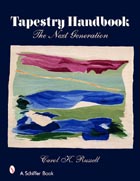
Tapestry Handbook - The Next Generation
by Carol K. Russell
8 3/4" x 11 1/4" Hardcover (216 pages)
2007, Schiffer Publishing Ltd.
This classic book, now completely revised and expanded, has long been a favorite of both teachers and students of tapestry weaving.
Learn to weave tapestry on any kind of loom, vertical or horizontal. Take an intriguing journey to make an elaborate, but logical, tapestry sampler. The process is explained step-by-step and illustrated with over 300 beautiful color photographs and diagrams of tapestry techniques. Along the way, color theories applicable to tapestry are explained.
You will be inspired by the ancient art form explored on these colorful pages. Treasures from museums and prominent contemporary artists relate the historic significance of tapestries and their limitless range of visual power. Learn how archival finishing and mounting your handwoven textile completes the project.
A chapter on designing for tapestry provides tools for translating future concepts into compositions. Be a part of this ancient, yet completely modern, weaving tradition.

Tapestry Loom Techniques - A Guide to Exploration on the Two Harness Loom
by Jules Kliot
4" x 10" Softcover (36 pages)
1999, Lacis Publications
Tapestry loom weaving has the potential of being the most creative of weaving techniques requiring maximum involvement of the weaver. While many of these weaver controlled weaves are worked using alternating sheds, many weaves are controlled by the fingers alone, the hands becoming directly involved with the fibres of the fabric. An intimacy between the weaver and his/her work is the result of this pursuit. The therapeutic value in terms of creativity and self expression should be welcome by both the young and the old. This creativity can find it's expression in terms of design or in the exploration of materials, colour, textures and stitches, or a comfortable combination of these elements.
This book is an excellent introductory guide to tapestry weaving. It starts by covering tools and materials and then goes on to provide descriptions and use of 65 different tapestry weaves including such techniques as: "Dovetail, "Limning", "Brocade", "Paired Wefts", "Warp Aligned Chain", "Greek Soumak", "Ghiordes Knot", "Scottish Pile", "Sprang", "Square Knot Sennit". The book is illustrated with clear line diagrams showing the weaves.
The author has also written: Kumi Himo: Techniques of Japanese Plaiting, Sprang: Language & Techniques and The Vertical Loom - Principles and Construction.
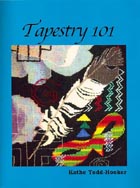
Tapestry 101
by Kathe Todd-Hooker
8 1/2" x 11" Spiralbound Softcover (108 pages)
2007, Fine Fiber Press
This book is a beginning course for the person interested in learning how to do woven tapestry.
It will give the reader the foundation they need to understand tapestry weaving and be able to express themself in this wonderful medium. There are plans for a simple, but competent loom, information on the equipment and materials the reader will need for weaving, and instructions on doing the basic techniques that they need to know to complete their own tapestry.
Each section builds on the previous one in the same way that the author's beginning tapestry workshop has lectures and demonstrations. As a beginning tapestry weaver, the book contains the information the reader will need to give themselves a good foundation for weaving their own art pieces. If they have already woven some tapestries, the book may fill in some gaps, answering some of the questions the reader might have encountered during their weaving experiences.
There is also information on finishing and mounting the tapestry for exhibition. Even if the reader has been weaving for awhile, the author has covered information on all aspects of tapestry weaving that will be a help to them.
There are 108 pages of written information, diagrams, and photographs with a spiral binding so that the book can be laid flat beside the loom as a reference while weaving.
Other books by Kathe Todd-Hooker include: Line in Tapestry, Shaped Tapestry and So Warped - Warping a Loom for Weaving Tapestry.
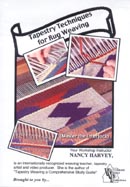
Tapestry Techniques for Rug Weaving
instructed by Nancy Harvey
DVD Video (142 minutes colour)
Victorian Video Productions
This comprehensive video thoroughly explores warp and weft interlocking tapestry techniques. A thorough discussion of general warping and weaving tips as they relate to rug weaving is presented. It includes tips on joining wefts, edge control, weft direction and the cause and elimination of those dreaded "ridges". The viewer will learn how to weave each interlocking technique with the wefts travelling in the same and opposite direction as we explore weaving diagonal and vertical joins.
There are many variations to each technique and the look changes depending upon whether you turn on an up or down warp thread. The viewer will weave and compare the results of each variation as they explore vertical joins and lines that slant to the right, left, and both directions. Tips on horizontal and vertical stripe techniques and finishing are also included.
While there are no specific course prerequisites, it is assumed that the viewer understands basic weaving terminology, knows how to calculate warp for a project, can dress a 4-shaft loom and can read a weaving draft.
Equipment and Materials required include a 4-shaft loom, some heavy warp like an 8/4 or 8/5 linen or a wool or cotton warp with about 600 yards per pound. For sampling, a variety of wool wefts may be used including singles and plied wool with about 500-550 yds/lb.
The package includes 2 DVDs and a written information sheet which includes a chapter guide.
Nancy Harvey has also written the book Tapestry Weaving: A Comprehensive Study Guide and instructs in the videos Tapestry Weaving - Level I and Tapestry Weaving - Level II.
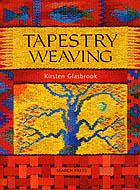
Tapestry Weaving
by Kirsten Glasbrook
8 1/2" x 11 1/2" Softcover (96 pages)
2002, Search Press
This colourful, exciting book offers a rich source of stimulating and innovative ideas that will appeal to all abilities.
The author uses her evocative designs to illustrate the techniques with step-by-step guidance on how to create horizontal and diagonal lines, curves, motifs, shading, outlines, borders and more. Here you will discover all you need to know about tapestry weaving from choosing colours and winding warps to creating images and finishing off with tassels and beads.
Illustrated throughout with beautiful examples of the author's work and including practical, detailed instructions on all the techniques, this fascinating book will inspire you to create your own designs.
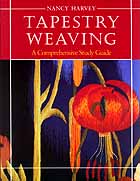
Tapestry Weaving - A Comprehensive Study Guide
by Nancy Harvey
8 1/2" x 11" Softcover (208 pages)
Learn tapestry weaving from start to finish with this thorough guide. Hundreds of problem-solving tips are presented along with dozens of photos. Nancy Harvey has selected the best advice from her two earlier tapestry books, added extensive new material, and rolled them into one. She'll walk you through two sample projects, and show you how to deal with all the decisions that come up in tapestry weaving - when to move wefts in the same or opposite directions, when to use different kinds of joins, how to select the right shed at any given time. She's added dozens of helpful tips that have come from years of experience and selected a gallery of contemporary tapestries for inspiration.
Nancy Harvey also instructs in the videos Tapestry Techniques for Rug Weaving, Tapestry Weaving - Level I and Tapestry Weaving - Level II.
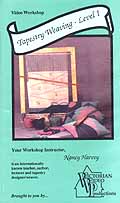
Tapestry Weaving - Level I
instructed by Nancy Harvey
DVD Video (110 minutes colour)
Victorian Video Productions
Tapestry Weaving - Level I will teach you how to successfully weave horizontal, vertical, diagonal, circular, vertical curving and horizontal curving shapes. It includes many technical considerations as well as finishing and mounting tips. As you weave three sample projects 14" x 14" (suitable for pillows), you will learn many techniques including slit, interlocking, outlining, pick and pick and horizontal stripes. Once you complete this course you may wish to go on to Tapestry Weaving - Level II which teaches shading and blending techniques.
If you are new to weaving, the Introduction to Weaving video is a helpful prerequisite. If you have woven on a loom before, there are no prerequisites. As for equipment and materials, any type of floor loom may be used. Instructions for assembling a small nail frame (as shown on the cover) are included on the written insert, along with the list of all the materials needed.
Nancy Harvey has also written the book Tapestry Weaving: A Comprehensive Study Guide and instructs in the videos Tapestry Techniques for Rug Weaving and Tapestry Weaving - Level II.
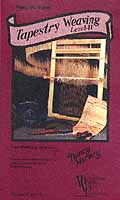
Tapestry Weaving - Level II
instructed by Nancy Harvey
DVD Video (107 minutes colour)
Victorian Video Productions
Tapestry Weaving - Level II includes many advanced techniques as shown in the small piece on the cover. During the course, this will be made into an attractive tote bag. This video continues where Level I left off, and includes tips and techniques as they apply to weaving both from the front and the back side of the tapestry. Techniques include horizontal shading (hatching, hachures and floating bars), vertical outlining, refinements of double weft and single weft interlock and how to create overlapping transparent imagery. Ways to plan a project, prepare a cartoon and colour sampling are also presented along with a selection of tapestries which incorporate the many techniques included in the course. Many functional and useful projects can be woven in tapestry technique, such as pillows, rugs, tote bags, wall hangings and even clothing.
Tapestry Weaving Level I is a prerequisite to this course. If you are familiar with basic tapestry techniques (slit and interlocking) and know how to weave with wefts travelling in the same and opposite direction of one another, and how to weave area by area, there are no prerequisites. The materials needed for this course include any type of loom from a simple self-constructed nail frame to a large frame, floor or tapestry loom. Also, you will need several skeins of different sizes of wool yarn and cotton warp thread. A detailed list of materials needed is included in the package along with a pattern for the project.
Nancy Harvey has also written the book Tapestry Weaving: A Comprehensive Study Guide and instructs in the videos Tapestry Techniques for Rug Weaving and Tapestry Weaving - Level I.
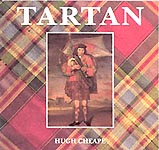
Tartan - The Highland Habit
by Hugh Cheape
8 1/4" x 7 3/4" Softcover (96 pages)
1995, National Museums of Scotland
When the Apollo spacecraft landed on the moon Allan Bean, one of the crew reverentially laid a swatch of MacBean tartan on the moon's surface. Tartan is a symbol of kinship and belonging in Scotland, and a badge of identity recognized all over the world.
Alongside the powerful historic and national resonance tartan has for Scots is the fact that it has been borrowed repeatedly by fashion. Today, we are as likely to meet tartan in a couturier dress as in a kilt or plaid. Tartan is distinctive in colour, style and design. It conveys personality, ceremony and drama. All these aspects of its character have contributed to tartan being one of the best known and best loved fabrics in the world
The origins of tartan are remote. Tartan's history is nevertheless fascinating, thought it has been scrutinized with the eye of sentiment more often than of reason. Much of Scottish history has been dogged by speculation based on slender knowledge, by the mixing of truths and half-truths, and tartan is no exception. It history has been coloured by strongly held opinions and enthusiastic intuition, yet there is a well-documented story to be told.
The word "tartan",probably French from the word "tiretaine", was in use early in the sixteenth century, a period when Scotland was dynastically linked to France. The French tiretaine described a half-wool, half-linen cloth, sometimes described in English as 'linsey-woolsey'. It seems likely that, in some way we can't now trace, this word came to describe the fabric we now call tartan.
The use of checks and stripes in patterning cloth was known in prehistory, and must be almost as ancient as weaving itself. A piece of third-century fabric excavated in Falkirk shows a simple check, a form of design which survived known more recently as "Shepherd's Plaid". Simple decorative weaving was known in all early cultures. Dark and light natural shades of wool were separated out and woven together in regular patterns. This early introduction of pattern into weaving shows how fabric and clothes were seen not just as protection but as an expression on creativity.The story of tartan is told from the medieval love of display to the Victorian invention of exclusive clan identity. Along the journey, the history of the Highlands and its society is brought vividly to life.
In the latest edition (the third) of this classic and best selling book are 16 new pictures, details on women's Highland habit and revelations following recent dye tests on a kilt allegedly worn by Bonnie Prince Charlie.
A fresh and vivid interpretation, this book also includes a section on individual clan tartans - invaluable for those interested in their Scottish ancestry. This full colour section enables the reader to find their own tartan and family history.
The author is curator of Modern Scottish History at the National Museums of Scotland and has a particular interest in Gaelic culture.
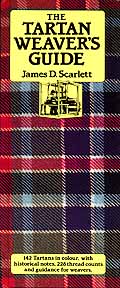
The Tartan Weaver's Guide
by James D. Scarlett
4 1/2" x 10 1/4" Hardcover (65 pages)
1995, Sheppard-Walwyn (Publishers) Ltd.
$21.95 Canadian ($17.95 US)
The Tartan-Weaver's Guide provides the weaver and student with useful and authentic information about tartan and tartan weaving. 142 tartans (including the cover) are illustrated in full colour to show the rich variety achievable with the simple techniques described. The basis of any tartan, as the author points out, is a simple two colour check which may be varied by the addition of overchecks, bands and stripes in the contrasting colours so arranged as to give a balanced and harmonious pattern.
The illustrations in the book show tartans in the popular so-called 'Old' or 'Ancient' colours used by Highland weavers before the invention of synthetic dyes, and show the patterns more clearly than do the stronger 'Modern' colours, though the actual thread counts are the same.
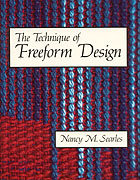
The Techniques of Freeform Design
by Nancy M. Searles
8 1/2" x 11" Softcover (160 pages)
1990, Home Mountain Publishing Co., Inc.
The concept of freeform design involves bending the lines of traditional block weaves so that a 2-dimensional design of any shape may be created wherever desired in the piece. The look of the traditional weave (its weave structure) is retained, but weavers are able to free themselves from the vertical and horizontal lines established by the threading and treadling of traditional block weaves.
While this is not a new idea, with the drawloom having been used by weavers to accomplish this very thing for the past 5 centuries, the author's interest has been to develop a method of freeform design for the four harness loom with no draw system or pick-up stick. After learning how to weave damask on a 4-harness loom, she extrapolated the technique for use with other block weaves and describes these in specific chapters on Twill, Overshot, Summer & Winter, Ms & Os, Huck, Lace Huck, Bronson Lace, Brocade, Double Weft Twill, Double Weft Summer & Winter, Double Weft Marsh, Broadweft Summer & Winter, Broadweft Ms & Os, Double Weave and Finnweave.
If you are looking for a way to develop handwoven designs as a result of the weave structure and if you are limited to four harnesses, this is the book for you. Nancy Searles leads the reader through a series of steps which produce an effect similar to the damasks and brocades normally woven on a draw loom or jacquard loom. In fact, the introduction, entitled "Heritage," includes a capsule history of these looms, as well as the use of the dobby head and computers to control harness action. The culmination of this brief overview is the freeform design technique developed by Ms. Searles. She defines the technique as a "system comprised of one threading sequence which is repeated selvedge-to-selvedge, and which can be treadled to produce at least two different weave structures by using separate harness combinations for each of the weaves." Essentially, the technique is a development of pick-up methods where a sequence of sheds is picked up on one or more sticks, the combination of sheds is then opened with a shed sword, and the shuttle is thrown-or pushed-from selvedge to selvedge. In Ms. Searles' approach, the shuttle itself is used to "pick up" a variety of sheds in its trip across the warp.
The book is divided into two sections: the first covering nine structures which are derived from traditional four harness block weaves such as twill, Summer and Winter, and bronson lace; and the second covering two-weft weaves which are heavier. The text proceeds in a detailed and easily followed fashion. Drafts and diagrams clearly direct the process. A number of photographs illustrate design possibilities, although my own inclination would have been to avoid some of the more "homey" graphic designs. I did especially like the ample feel of the book. The layout uses white space to set off the photographs and the type is of sufficient size to make reading the next step while seated at the loom a reasonable undertaking. I also like the inclusion of a "suitable projects" section under each weave structure chapter to guide the reader.
One of the most attractive features of The Technique of Freeform Design is the "insights" column at the inner edge of each page. Included here are comments on the process, additionals ideas on making it easier, and thoughts which are helpful but which might interrupt the descriptive flow of the main text. Described are such topics as the "heritage"of a particular weave, the use of color, how to tie the warp to the front apron rod, and an edge finishing method, Also included are inspirational words by other authors-Thoreau, Mark Twain, Robert Frost, Leo Rosten to name a few, who have commented on weaving in relation to the whole web of life. Especially effective are the quotations from the author's great-grandfather, Elbert Hubbard, himself an author and teacher. The final page carries this sentence from him: "The best service a book can render you is, not to impart truth, but to make you think it out for yourself." This book plays that role, inspiring and guiding the reader to find satisfaction in exploring a new way to handwoven design.
The material presented in this book is for the intermediate to advanced weaver who wishes a new creative approach to weaving and an enjoyable challenge. However, enough guidlines and hints are given that a new weaver should be able to use the technique with confidence. This book is extensively illustrated with pictures showing finished weaves and line drawings explaining the technique.
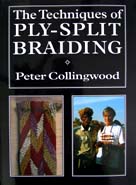
The Techniques of Ply-Split Braiding
by Peter Collingwood
7 3/4" x 10" Hardcover (304 pages)
1998, Unicorn Books
$72.95 Canadian ($60.95 US)
Ply-split braiding is a thread technique which is still too little known in Europe.This book is the first in-depth investigation of a technique which due to its extremely localized distribution, has only recently come on to the textile map.
Peter Collingwood, as in his other definitive works on rugs, sprang and tablet weaving, has delved deeply into the technique of ply-split braiding. On five visits to India he has traveled to isolated of-the-map villages and homesteads in Rajasthan and Gujurat to gather knowledge from the few remaining practitioners of this craft and also acquire a unique and impressive collection of artifacts.
The latter have been the foundation for the present book which contains detailed practical instructions for the reader and records these arrestingly beautiful objects. The plates - both of Indian work and the author's own innovative samples - illustrate the range of designs and structures this simple method, which needs practically no equipment, can produce. Ply-split braiding will become an exciting new addition to the textile worker's craft.
This book is lavishly illustrated with line drawings showing the techniques and patterns. Almost 100 pages at the back are filled with black and white photographs of the finished works and the local craftsmen who made them making it a wonderful guide to the techniques as well as a unique permanent record of this art form.
Other works by this author include: The Maker's Hand, Peter Collingwood - His Weaves and Weaving, Rug Weaving Techniques: Beyond the Basics, The Techniques of Rug Weaving, Techniques of Sprang and The Techniques of Tablet Weaving as well as the The Journal for Weavers, Spinners and Dyers - Peter Collingwood Special Edition compilation of articles.
CLICK TO SEE OUR TABLET WEAVING CARDS AT A VERY AFFORDABLE PRICE!
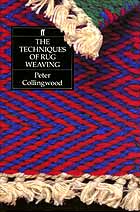
The Techniques of Rug Weaving
by Peter Collingwood
6 1/4" x 9/14" Softcover (576 pages)
1993, Faber and Faber Ltd.
Peter Collingwood's classic book on rug weaving, recognized world-wide as the definitive work, now appears in paperback for the first time, revised and updated. This is the first book to provide such a complete account of rug weaving covering the subject from its simple beginnings up to the attainment of a professional standard.
After preliminary chapters on specialized equipment, yarns and methods of setting up a rug loom, the main part of the book is devoted to that immense range of rug weaving techniques about which most handweavers know so very little. These are described in three chapters, on various types of weftface rug in plain weave and in chapters on weftface weaves needing up to eight shafts, on blockweaves, on pick-up weaves, on corduroy pile rugs of many types, on warpface rugs of all kinds, on warp and weft twining, and on all types of rug finish. A large part of this material, the majority of which has never previously appeared in print, stems from the author's research into old techniques, but more especially from the development of new techniques which has been the hallmark of his workshop over the past years.
The careful description of techniques is backed up by over 400 specially drawn and very explicit diagrams and 170 detailed photographs mainly of the author's own work.
Peter Dodgson Collingwood was born in 1922 and qualified as a doctor in 1946. He decided to give up medicine for weaving in 1950 and worked in the weaving studios of Ethel Mairet, Barbara Sawyer and Alastair Morton. In 1952 he set up his own workshop, concentrating initially on weaving floor rugs in original techniques and then on weaving hangings in the Macrogauze technique. He has taught at Hammersmith, Camberwell, Central and Farnham Schools of Art, and he also makes regular teaching trips to America. He has exhibited widely in Europe and America and has held oneman shows at the Craft Centre, the Building Centre and the Victoria and Albert Museum. His commissions include rugs for New Zealand House, London, and wall hangings for the Shell Tower, the University of York, Grindlays Bank, and Selwyn College. He is married and has two children. His son Jason Collingwood is also a rugweaver and weaving teacher.
With inventiveness and a trained scientific mind, this great weaver has designed his way out of the slow, traditional methods which do, indeed, seem out of place in our twentieth century. Through research and discovery he has broadened the whole range of rug techniques. It is the sharing of these discoveries that makes the book so important. As one can easily imagine, Mr Collingwood writes - and illustrates - with the same grace, and brilliant organization, with which he designs and weaves.Jack Lenor Larsen
Other works by this author include: The Maker's Hand, Peter Collingwood - His Weaves and Weaving, Rug Weaving Techniques: Beyond the Basics, Techniques of Ply-Split Braiding, Techniques of Rug Weaving, Techniques of Sprang and The Techniques of Tablet Weaving as well as the The Journal for Weavers, Spinners and Dyers - Peter Collingwood Special Edition compilation of articles.
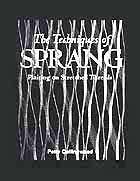
The Techniques of Sprang - Plaiting on Stretched Threads
by Peter Collingwood
7 1/2" x 9 1/2" Softcover (334 pages)
1999, Design Books
A groundbreaking study first published more than twenty years ago and long unavailable, this is the definitive work on the fabric-making process known as sprang. For at least 3,500 years, this finger-controlled technique has been used where a stretch fabric was required, but its revival today is based mainly on its many decorative and structural possibilities. In addition to chapters on the definition, history, and terminology of sprang and equipment and setup, the book covers the immense range of sprang techniques, illustrated with 160 diagrams and photographs of samples. A practical book for those who want to learn and explore the technique, it is also valuable for textile students and researchers.
This book is extensively illustrated throughout with line drawings showing the techniques used plus almost 70 black & white photographs at the end showing the finished works.
Other works by this author include: The Maker's Hand, Peter Collingwood - His Weaves and Weaving, Rug Weaving Techniques: Beyond the Basics, Techniques of Ply-Split Braiding and The Techniques of Tablet Weaving as well as the The Journal for Weavers, Spinners and Dyers - Peter Collingwood Special Edition compilation of articles.
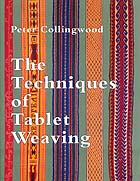
The Techniques of Tablet Weaving
by Peter Collingwood
8 1/2" x 11" Softcover (320 pages)
2002, Robin & Russ Handweavers
This 320 page manual presents the most complete instructional and historical documentation on tablet weaving ever contained in one book. The techniques are categorized into 17 weave structures with chapters devoted to each. Close-up photographs, pattern drafts, and step-by-step diagrams illustrate each technique. In addition to providing historical background, the text includes concise instructions with helpful hints for reproducing each technique and many new variations. Both weavers and collectors alike will benefit from this extensive research.
After a chapter on the history of Tablet Weaving and a description of the terms used, the author identifies the equipment required by the tablet weaver which includes tablets, various warp tensioning devices and beaters, combs and shuttles as well as the yarns required. The warping process is then described along with an explanation of threading diagrams. This is followed by an explanation of the tablet weaving process itself in sections titled "Threading and Manipulation of the Tablets" and "Starting, Finishing and Varying the Width of a Band". After categorizing and explaining the basic weave structures in a number of chapters, the author expands upon these by covering Weft and Warp Manipulations and identifying ways of producing a warp twined structure without tablets using Ply-Split Darning, Loop Manipulation, Aya-Take-Dai, Maru-Dai, Manipulation of Stretched Threads, Throwing Warp across the Weft, Methods used in Passementerie and Industrial Methods.
The book finishes with a series of appendices that among other things includes a fascinating account of the controversy over what the author calls "the so-called Rameses Girdle". An extensive Bibliography and Index complete this wonderful reference book which includes 240 diagrams and 232 B/W plates. First printed in 1982, this invaluable reference for tablet weavers quickly sold out and this revised edition features digitally enhanced, clearer photos than the first edition.
Other works by this author include: The Maker's Hand, Peter Collingwood - His Weaves and Weaving, Rug Weaving Techniques: Beyond the Basics, Techniques of Ply-Split Braiding and Techniques of Sprang as well as the The Journal for Weavers, Spinners and Dyers - Peter Collingwood Special Edition compilation of articles.
CLICK TO SEE OUR TABLET WEAVING CARDS AT A VERY AFFORDABLE PRICE!
Textile Arts Index (1950-1987)
edited by Sayde Tune Wilson & Ruth Davidson Jackson
9" x 11 1/2" Hardcover (1006 pages)
1988, Tunstede
Trying to locate articles on Irish Tweed, Chevron Weaves, Peruvian Weaving Techniques or on how best to photograph textiles? Want to find a complete list of the articles and monographs published by Peter Collingwood, Mary Black or Harriet Tidball?
For anyone researching a Fibre Arts related subject or who wants an easy way to make searching through their stacks of weaving, spinning and knitting magazines a breeze, this volume is a must. It provides a complete listing of every article, report and monograph published on the subject over almost 40 years (from 1950 to 1987) in such journals as Ars Textrina, Complex Weavers, Fiberarts, Handweaver & Craftsman, Handwoven, Interweave, Knitters, Master Weaver Library, Prairie Wool Companion, Shuttle Craft Guild Monograph, Spin-off, Shuttle, Spindle & Dyepot, Threads in Action Monograph, Threads Magazine, The Textile Museum Journal and Weaver's Journal. The articles are first arranged by subject and then by Author with information on the issue, date and even the page number of the reference. A valuable tool for saving your time and making your magazine collection work for you!
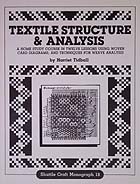
Textile Structure & Analysis
by Harriet Tidball
8" x 10 1/2" Softcover (31 pages)
1966, ShuttleCraft Books, Inc.
$12.95 Canadian ($10.95 US)
This is described as "A Home Study Course in Twelve Lessons using Woven Card Diagrams; and Techniques for Weave Analysis" and is Monograph Eighteen from the Shuttle-Craft Handweavers Guild
This monograph presents not only the methods for making card interlacements with their many variations, but also a systematic study of textile structure through twelve lessons. The study is suitable for the individual weaver or as a subject for a study group, and criticism of lesson work from the outside is not needed. For those who do not care to include the study of textile analysis, the final four exercises for four lessons may be disregarded and the last lesson omitted, making an eleven-lesson course in textile structure. This book draws on two other books: The Weaver's Book and The Handloom Weaves for the studies.
Click Here for a complete list of the monographs in the Shuttle-Craft Guild series.
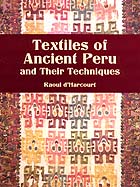
Textiles of Ancient Peru and their Techniques
by Raoul d'Harcourt
8 1/2" x 11 1/4" Softcover (303 pages)
2002, Dover Publications, Inc.
Famed for their weaving expertise, pre-Columbian Peruvians produced textiles not only rich and varied in effect but also comparable, if not superior, to Old World fabrics. This volume,widely considered the definitive study on the subject, describes in meticulous detail the ancient Peruvians' textiles and techniques.
The informative introduction examines such raw materials as agave fiber, cotton, and wool from the llama, alpaca, and wild vicufia; it also considers yarns, dyes, and looms. The first of the two-part text focuses on a variety of weaves-twills, gauzes, open-work fabrics, and much more. The second section deals with the techniques and materials related to nonwoven substances such as braiding, networking, felt, embroidery, and trimming. The heart of the book consists of hundreds of illustrated examples of authentic, well-preserved textiles, tapestries, and personal items.
Hailed by American Anthropologist as "of importance both to Peruvianists and to those concerned with the history of textiles in general," this magnificently illustrated study of fabric structure was also acclaimed by Scientific American as "an incentive, an inspiration, and a guide." This book is well illustrated with approximately 465 halftones and line illustrations.
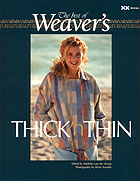
Thick'n Thin - The Best of Weaver's
from Weaver's Magazine
8 3/4" x 11" Softcover (107 pages)
2001, XRX Books
$35.95 Canadian ($29.95 US)
Thick'n Thin is the second in a series of Best of Weaver's books: collections of treasured articles from more than 10 inspiring years of Weaver's and the Prarie Wool Companion magazines. More than thirty projects by 23 of the magazine's talented designers give complete and easy-to-follow instructions for weaving drapable fabrics for a multitude of uses: clothing, rugs, blankets, kitchen towels, table linens, scarves and more.
For the weaver who enjoys creating original designs, find here all the tools you need to design and weave your own fabrics in thick'n thin. This definitive work on thick'n thin weaves includes: block design with thick'n thin, network drafting with thick'n thin, comprehensive primer on warp rep, thick'n thin double weave, thick'n thin warping tips and over thirty projects.
Articles and projects in this book include: "thick 'n thin tips", "thick 'n thin theory", "thick 'n thin scarf and jacket", "overshot patterning in diversified plain weave", "fleece for the 21st century", "network drafting through thick and thin", "cozy throws in diversified plain weave", "Christmas table runners", "hearts and flowers scarves", "log cabin with thick 'n thin", "beyond log cabin", "towels in thick 'n thin", "thinner, thin, thicker, thickest:color-and-weave on two shafts", "three blocks on three shafts", "magic pleats - from eight shafts to two", "patchwork rugs", "patchwork is not just for rugs", "beyond tied weaves", "peach sherbet scarf", "macintosh vest", "forty-five easy pieces", "shadow box scarf", "reach for the stars", "glowing crosses runner", "the incredible five-color afghan for a super kid", "the mystery weave", "mystery weave vest and placemats", "paired-tie thick 'n thin", "paired-tie throw", "design a wardrobe with crackle", "herb gardening hat", "one, two, three vest, thick 'n thin throw", "pizza cloth for four, eight or sixteen", "Angstadt pizza placemats", "color control through thick and thin", "Rainbow rayon rep belt", "ripped about rep", "warp- and weft-faced lampas", "networked thick 'n thin lampas pillows".
The other books in the Best of Weaver's series include: Fabrics That Go Bump, Huck Lace, The Magic of Doubleweave, Overshot is Hot!, Summer & Winter Plus and Twill Thrills.
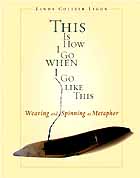
This Is How I Go When I Go Like This - Weaving and Spinning as Metaphor
Linda Collier Ligon
5 1/2" x 7" Softcover (143 pages)
2004, Interweave Press
As founder and editorial doyenne (certainly "tutelary spirit") of Interweave Press, Linda Ligon has charmed and challenged readers for decades with her intelligent, witty, high-spirited, and always provocative essays.
For twenty-five years, Ligon has offered up her wonder, puzzlement, joy, sass, consternation, and wisdom to an audience of weavers who share her passion for the fiber arts. This Is How I Go When I Go Like This gathers the best of Ligon's reflections, sometimes serious, sometimes funny - "I am confounded. Thwarted, conquered, vanquished, licked, lathered, clobbered... And all by a cone of yarn," confesses weaver, spinner, and publisher Linda Collier Ligon. Her frank and funny account of being whupped by a challenging weaving project is just one of many endearing stories she has shared. No object or behavior is to ordinary a strand for the sparkling stories she weaves. Whether meditating on the zigs and zags of ric-rac, rushing to finish spinning and weaving a blanket for her son before he grows up and out of her home, or tallying the mishmash of yarns and fibers she has acquired over the years, Ligon celebrates the soulful practice of weaving and spinning. For her, it was and remains simply "the ballast, the glue, the center." And for readers of this charming collection, it's back to the loom!
These essays trace the ups and downs, the joys and trials, the people and events of the world of handweaving-and of Handwoven magazine that has supported (and been supported by), led, and celebrated that world. The collection's extraordinary pleasures involve textiles and language equally-whether the author is exploring what it means to have a "loom-shaped life" or asking the questions "What's warp, what's weft." "What are the interlacements?" Her precise, probing, and often quirky language and thoughts are always engaging.
Linda Ligon started Interweave Press on her dining room table in 1975 when her third child was born. Her publishing company has grown from a small regional magazine to seven diverse magazines and more than 150 books in print, and from that home-based sole proprietorship to a corporation with more than 60 employees. She is currently CEO and Editorial Director of Interweave Press. She lives and works in Loveland, Colorado.
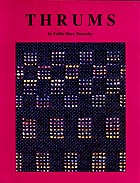
Thrums
by Faithe Shaw Nunneley
8 1/2" x 11" Softcover (134 pages)
1991, Flower Valley Press
This book is a delight to read and full of such down-to-earth and useful information, you'll keep it near at hand all the time. The author's light humorous style keeps you going from page to page as you pick up tips, hints and just good ideas on how to handle the nitty gritty problems you come across in weaving and dyeing. Chapter headings include: "Handweaving as Mania", "Getting Started", "Tools of the Trade", "Yarns - Your Raw Materials", "Weaves and Warp Finishes", "Colour is Everything", "Clothing Fashion and Design", "Disasters - Their Cause and Cure", "The Casual Dyer - Yarn Dyeing is a Piece of Cake", "Finishing Textiles", "Guilds - Study Groups - Conferences", "Housekeeping and the Handweaver", "Murphy's Law", "The Peripatetic Handweaver" and "Leaves From a Memory Book - Anecdotes and Folklore of the Weaving World".
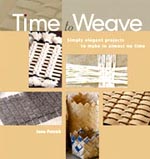
Time to Weave - Simply Elegant Projects to Make In Almost No Time
by Jane Patrick
8 1/2" x 9" Softcover (128 pages)
2006, Interweave Press
$25.95 Canadian ($21.95 US)
One look at these gorgeous projects and your fingers will beg to learn a new craft! The beautiful, textural objects in Time to Weave - like plaited paper baskets, woven lanterns, hearth rugs, sachets, and cork table mats-offer an approachable and inspirational way to learn the fundamentals of non-loom weaving for the first time.
Drawing on ancient and traditional techniques, author Jane Patrick, past editor of Handwoven magazine, uses everyday materials like copper tape, plastic sheeting, shrink tubing, paper yarn, and granite tiles to create stunning contemporary objects for the home. Patrick focuses on embracing a sense of place and appreciation for the natural world in these 18 simple weaving projects, and encourages a choice of reconstructed, recycled, vintage, or natural materials.
Non-loom techniques in Time to Weave include braiding, stringing, knotting, frame loom weaving, straw weaving, weaving over a pillow form, and more. Projects range from a sticks-and-string coaster, canvas strip pillow, pocket purse, woven paper cards, "waves" window hanging, and more. Clear step-by-step instructions and photography are provided for each design, and each project features ideas and variations for further exploration.
Projects call for simple equipment and tools and materials that are easily available. Each project is introduced with a quote and short essay about the process of making the piece, the materials, or sometimes musings about the process of creation and how this fits in with daily living. Patrick encourages readers to weave with a purpose and enjoy the process of creation as much as the outcome. Also included are hints, resources, and suggestions for further reading.
If you've never tried weaving, now is the time - explore this limitless craft with Time to Weave! Learn the art of non-loom weaving with this new approach, focusing on the creative process as much as the finished product.
The complete list of projects include: "Cork Mat", "Hearth Rug", "Woven Paper Cards", "Lantern Lamp", "Plaited Paper Basket", "Waves Window Hanging", "Sticks and String Coaster", "Tile Wrap", "9-Strand Necklace with Beads", "Spring and String Choker", "Braided Rope Mats", "Canvas Strip Pillow", "Pocket Purse", "Egg Hat", "Pile Patch" and "Fuzzy Collar".
Jane Patrick grew up on the broad plains of south central Nebraska where, from an early age, she earned the moniker of "the family putzer" because she was always making things. It wasn't until she walked into the weaving studio at Longumyri home economics school as an exchange student in Iceland that she knew that weaving was something she must do. Since then weaving has been both her livelihood and her hobby. She has taught weaving classes/workshops, given lectures on weaving, and juried textile art shows and now lives in Boulder, Colorado.
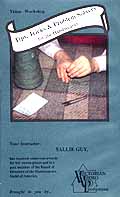
Tips, Tricks & Problem Solvers for the Handweaver
instructed by Sallie Guy
DVD Video (60 minutes colour)
Victorian Video Productions
Tips, Tricks & Problem Solvers for the Handweaver includes a detailed presentation of a number of tested, practical and timesaving ideas which will facilitate the entire weaving process. In addition, constructive imaginative approaches to correct problems encountered when warping and weaving will be demonstrated. All of these have been developed as a result of over twenty-five years of "trial and error" at the loom, plus ideas shared by other weavers. These tips will help you at every stage from planning, to warping, to weaving, to finishing the woven textile.
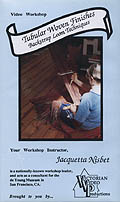
Tubular Woven Finishes - Backstrap Loom Techniques
instructed by Jacquetta Nisbet
DVD Video (87 minutes colour)
Victorian Video Productions
An overview of Andean textiles will give you an initial concept of the artistry and inventiveness to be found in the designing and weaving of embellishments for ponchos, carrying cloths, and coca bags. This course will show you how to make a continuous warp with heddles and a shed loop, rearrange the warp order and pick patterns.
Starting with a plainweave band that teaches you the basic techniques of backstrap weaving you can progress through supplementary and complementary warp-patterning and warp substitution to the complex and beautiful crossed and diverted warp tubular weave - "the little band of many eyes". Then you can design for and weave onto the textiles of your choice - as edging for a garment, ceremonial necklace, or self-plying fringe - while adding detail and durability to items of daily use.
While there are no prerequisites for this course, the student will need a warping board, inkle loom, of clamped pegs suitable for making narrow warps. About an ounce each of at least contrasting colors of 3/2 perle cotton and the same of a smooth, hard twist worsted wool. Also required is fine heddle cotton and strong string for ties. In addition, the student will need a piece of wood for a template for the fringe, along with a couple of c-clamps or wall hooks. A detailed list is included in the cassette along with pattern graphs.
This instructer has also produced the video Supplementary Warp Patterning Inkle Loom Techniques.
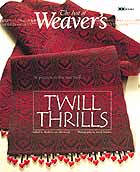
Twill Thrills - The Best of Weaver's
from Weaver's Magazine
9" x 11" Softcover (123 pages)
2004, XRX Books
Thrill Twills is the fourth in a series of Best of Weaver's books: collections of treasured articles from more than 10 inspiring years of Weaver's and the Prarie Wool Companion magazines. A collection of projects by the magazine's talented designers give complete and easy-to-follow instructions for weaving more than 30 projects on simple twills, twill blocks, advancing twills, snowflake twills, networked twills, and damasse.
Complete directions are given for weaving glorious scarves, shawls, garments, and table linens on four-shaft to 16-shaft looms. Full-color photos will inspire and entice all crafters to read and weave
This collection of projects and articles is divided into 4 sections. The first titled "Plain and Fancy Twills" includes the articles:"Twill Basics", "Blue Tick Hound", "Feathered Friends", "Redeeming the Dinos", "Extraordinary Stripes", "Fingertip Towels in one of the Worst Twills", "Happy Families: A Video Game for Weavers", "Samplemania! for a Vest, Jacket and Shirt", "Angstadt Twills: Solving a Weaving Puzzle" and "the Ear;'s Canvas". The second section "Advanced Twills" includes "Advancing Twills", "Composing Snowflakes", "Frost Crystals in Twill", "Snowflakes and Stars", "Variations on a Theme", "A Designer's Heart's Desire", "Heart-Throb Scarf", "Silk Snowflakes and Stars" and "No Two Alike". The third section titled "Network Drafting with Twills" includes: "Network Drafting: More for Less", "Network Drafting: Part II", "The Pattern Line: Telescoping and Digitizing", "The Pattern Line: Turtles, Snakes and Fleas", "Network Drafting for Eight", "The Workshop Network", "A Mix of Twills" and "Slim, Silk, Saddle-Shoulder Sheath". The final "Twill Blocks and Beyond" section includes "Glacier Scarf", "Pinwheel Top", "Twill Illusions with Two and Four Blocks", "Homage to Escher: Networked Imagery", "Fancy Twill Extravaganza on only Four Shafts", "Imagery in Advancing Twills", "Broken Windows: Networking Satin and Plain Weave", "Network Drafting: Some New Approaches" and "What's Black and White and Gray all over?".
The other books in the Best of Weaver's series include: Fabrics That Go Bump, Huck Lace, The Magic of Doubleweave, Overshot is Hot!, Summer & Winter Plus and Thick'n Thin.
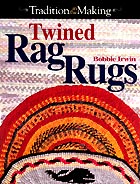
Twined Rag Rugs - Tradition in the Making
by Bobbie Irwin
8 1/4" x 10 3/4" Softcover (128 pages)
2000, krause publications
Twined rag rugs are undergoing a worldwide revival due to thousands of people who are rediscovering the traditional handiwork of their ancestors. Not only will Twined Rag Rugshelp you create wonderful, durable heirloom rugs, but you will benefit from the rhythmic relaxation of twining. All you need is some inexpensive equipment, simple household tools, scrap fabric, and the easy-to-follow instructions in this book. Even the most intricate patterns are easy to learn.
This inexpensive, simple technique can be enjoyed by crafters of all ages and skill levels; young children learn it easily and the elderly benefit from increased manual dexterity. And the result is an incredibly durable heirloom that can be passed through generations.
This book introduces numerous pattern and equipment options with step-by-step diagrams and photographs for nine samplers. Also included are complete instructions for building basic equipment, ten rug projects and tips for designing heirloom rugs. The projects include: "Turquoise Nuggets", "Barefoot Delight", "Remembering Lillie", "Just Jeans", "Twined and Intertwined", "Canyon Country", "Spirit of the Northwest", "North Star", "Celebration" and "Sunset". The author also profiles the work of 9 artists to create a wonderful gallery of designs that will inspire and provide ideas to the reader.
Other books by this author include The Spinners Companion.
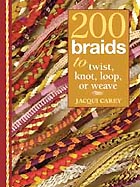
200 Braids to Twist, Knot, Loop or Weave
by Jacqui Carey
6 3/4" x 8" Spiralbound Hardcover (256 pages)
2007, Interweave Press
All projects benefit from that perfect finishing touch. Create a personalized braided trim to complete any project-from clothing, furnishings, greeting cards, jewelry, totes, gift wrap, floral arrangements, and more with 200 Braids to Twist, Knot, Loop, or Weave, no previous experience is necessary!
Choose from hundreds of sumptuous braided designs arranged by structure, from twisted and knotted pieces to more elaborate looped and woven examples, even those that incorporate beads.
Each braid features a beautiful close-up photograph, materials list, step-by-step instructions and clear easy-to-follow color illustrations to guide the reader along. Each technique used in the book is explored in-depth, followed by tips on starting and finishing braids, and advice for incorporating braids into other textile projects.
Any thread or fiber can be worked into a braid or trim, and little or no equipment is required to create each braid. Assembly is a breeze! Experiment with texture and color to make gilded, beaded, glittery, or jeweled creations. Custom design your own braids and trimmings for that extra special touch-the range of possibilities is endless!
Other books by this author include: Beads & Braids, Beginner's Guide to Braiding - The Craft of Kumihimo, Braids and Beyond, Chinese Braid Embroidery, Creative Kumihimo, Round the Twist and Samurai Undressed as well as: Braids: 250 Patterns from Japan, Peru & Beyond, Kumihimo: Japanese Braiding, Making Kumihimo: Japanese Interlaced Braids, Kumi Himo: Techniques of Japanese Plaiting and Kumihimo - Japanese Silk Braiding Techniques by other authors.
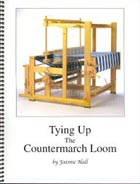
Tying Up the Countermarch Loom
by Joanne Hall
8 1/2" x 11" Spiralbound Softcover (34 pages)
2004, Joanne Hall
Page after page of beautifully clear drawings and explanations, make this book a necessity for any weaver with questions about the Countermarch tie-up. Many other details include several methods of arranging the texsolv beam cord to the tie-on bar, bundling texsolv or string heddles for easy use and storage, assembling and hanging the shafts, and tips on threading comfortably. The book includes many diagrams with close-up views of texsolv cord in use.
Common questions about countermarch looms are addressed, such as sagging shafts or use of unbalanced threadings. The back of the book includes a section on knots, sett and sley charts, metric equivalents, and a glossary of weaving terms. This small book has a wealth of information for anyone interested in dressing and tying up a traditional style loom efficiently.
The author also wrote Learning to Warp your Loom.
|
How to Order: Orders may be placed using our secure Online Order Form (this form should open in another window). Click Here for more information on how to place an order as well as our terms and conditions. Payment/Currency: Payment can be made using VISA or Mastercard, Cheque or Money Order in US or Canadian funds. US credit card purchases are billed directly in US funds eliminating any foreign currency conversion charges by the credit card company. Product Directories If you are looking for other items on our website, try using our product directories to quickly find what you are looking for! Our products are grouped as follows: Weaving/Spinning Product Index Books, Magazines & Videos. |
Price/Shipping Quote? If you would like an exact quote for any items complete with shipping costs, please call or email us at nmanners@camillavalleyfarm.com with you location and we will provide this. Gift Certificate If you are looking for a gift for a Knitter or Weaver and can't figure out what they want, a Camilla Valley Farm Gift Certificate is an excellent way to ensure you get the perfect gift! We can also email gift certificates if you are running out of time! Latest News/Updates Keep up to date with what is new at Camilla Valley Farm by following us on Instagram! (Click on the logo below)  |